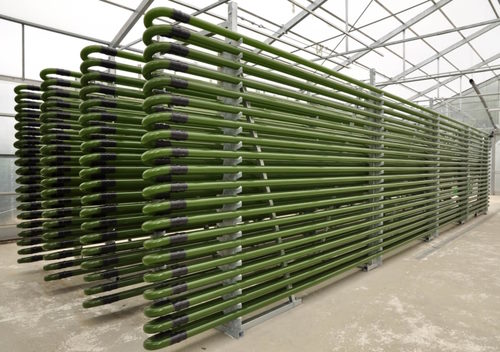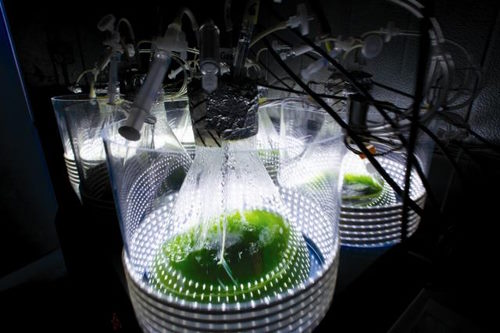
A photobioreactor refers to any cultivation system designed for growing photoautotrophic organisms using artificial light sources or solar light to facilitate photosynthesis. Photobioreactors are typically used to cultivate microalgae, macroalgae, cyanobacteria, and some mosses.
PBRs can be open systems like raceway ponds, that rely on natural light and carbon dioxide sources. Closed PBRs are adaptable systems that may be programmed to meet the physiological needs of the cultured organism, leading in ideal purity levels and growth rates. PBRs are commonly utilized in the growth of bioactive chemicals for use in biofuels, medicines, and other industrial applications.
Read on to learn more about photobioreactors, including the most common types and uses.
Types of of Photobioreactors
There are currently two most common types of photobioreactors available. These are:
Open Systems
The initial approach of regulated phototrophic species production was to employ a natural open pond (also known as an artificial raceway) pond.
The culture suspension contains all of the necessary nutrients and carbon dioxide, and is irradiated directly by sunlight through its surface.
Raceway ponds are still used in industries because they have cheaper operational expenses than closed PBRs. They do, however, provide insufficient control over the reaction conditions because they rely on environmental light and carbon dioxide, as well as the possibility of contamination by other microbes. Water leakage into the atmosphere is also caused by open technologies.

Closed Systems
Closed PBR construction decreases the risk of water loss from the system, and the possibility of contamination. Although closed systems perform better than open systems, they must be modified to be suitable for the production of low-cost commodities since cell density is still insufficient due to several limitations.
Modern photobioreactors have tried to strike a balance with a very thin film suspension of culture, less use of energy for pumps, optimal lighting, and capital expense, as well as the purity of the microbial population. However, light attenuation and an increase in CO2 needs with growth are two of the most frequent alterations to phototrophic cultures that significantly limit the efficacy of the photobioreactor.
Oxygen accumulation from photosynthetic sources like microalgae growth in photobioreactors is thought to be a critical factor, but it has been demonstrated using dynamic models that levels of dissolved oxygen exceeding 400% air saturation aren't inhibiting when cell density is high enough to block light intensity in the later stages of microalgal culture. Numerous ways have been tested, but only a few approaches could be applied on a broad scale.

Unique Feature of Photobioreactors
A photobioreactor is typically a three-phase system that includes a liquid phase (medium), a solid phase (cells), and a gas phase. Light, which is unique to photoreactors and is frequently referred to as the fourth phase, is the most important characteristic influencing reactor design since it controls microalgal growth and, hence, photosynthetic efficiency (Posten, 2009). As a result, light should be delivered at the right intensity, duration, and wavelength (Carvalho et al., 2011).
Light intensity diminishes exponentially with increasing distance from the reactor wall due to light shading effects caused by an increase in cell and product concentration (increasing turbidity) or the formation of biofilm on the surface of reactor vessels.
Algae Bioreactors
Algae bioreactors are used to grow micro or macro algae. Algae can be grown for biomass production (as in a seaweed cultivator), wastewater treatment, CO2 fixation, or aquarium/pond filtration in the form of an algae scrubber. Algae bioreactors are divided into two types: open reactors and enclosed reactors. Open reactors are exposed to the atmosphere, whereas enclosed reactors, also known as photobioreactors, are isolated from the atmosphere to variable degrees.
Algae bioreactors, in particular, can be used to produce fuels such as biodiesel and bioethanol, animal feed, and to minimize pollutants such as NOx and CO2 in power plant flue gases. This type of bioreactor is fundamentally based on the photosynthetic reaction, which is carried out by chlorophyll-containing algae using dissolved carbon dioxide and sunlight energy. To make the carbon dioxide available to the algae, it is spread throughout the reactor fluid. The bioreactor must be constructed of a transparent material.

Commonly Used Photobioreactors for Algae
At present, there are three basic forms of algal photobioreactors in use, but the determining factor is the unifying feature - the available intensity of sunshine radiation.
Flat Plate PBR
A plate reactor is basically a series of slanted or vertically stacked translucent rectangular boxes, which are frequently separated into two halves to impact reactor fluid agitation. In general, these boxes are linked together to form a system. These connections are also employed in the filling/emptying process, the introduction of gas, and the conveyance of nutritional substances.
The flue gas is mostly introduced near the bottom of the box to give the carbon dioxide adequate time to interact with the algae in the reactor fluid. These plates are often lighted from both sides and light penetration is high. The flat plate design has a limited pressure tolerance and requires a lot of area.
Tubular PBR
A tubular reactor is made up of vertically or horizontally organized tubes that are linked together in a pipe system. This tubing allows the algae-suspended fluid to flow. The tubes are often composed of clear polymers or borosilicate glass, and the constant circulation is maintained by a pump at the system's terminus.
The gas is introduced at the end/beginning of the tube system. This method of delivering gas results in a lack of carbon dioxide and a high concentration of oxygen at the unit's end during circulation, rendering the process inefficient. The microalgae growth on the walls of the tubes can also prevent light from penetrating.
Bubble Column PBR
A bubble column photo reactor is made up of vertically aligned transparent cylindrical columns. The gas is introduced at the bottom of the column, creating a turbulent stream that allows for optimal gas exchange. The bubbling works as a natural agitator as well. Light is normally supplied from outside the column, although newer designs incorporate lights within the column to improve light penetration and distribution.

